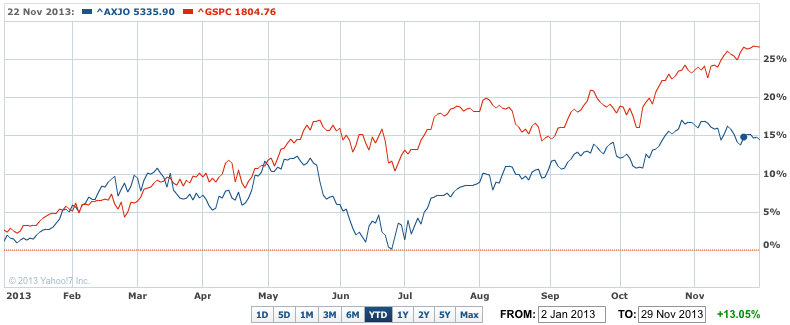November ended up a curious month for markets – some rose, some eased, some went sideways – and one or two bombed – led by gold.
In fact the confidence markets were on Wall Street, Hong Kong listed Chinese shares, Tokyo and Germany which all saw solid single digit percentage gains for the month.
The Aussie market suffered its weakest month since June – losing 1.9% for the first fall in five months. It lost 0.3% last week and would have ended steady but for Friday’s fall of 0.3%.
In the US, all three Wall Street major indexes – the Dow, the Standard & Poor’s 500 and the Nasdaq – had strong gains for the month.
The Dow had its third monthly gain, while the S&P 500 had its eighth weekly rise in a row.
In Friday’s half day post Thanksgiving trading the Dow fell 10.92 points or 0.07% to 16,086.41, the S&P 500 lost 1.42 points or 0.08% at 1,805.81 and the Nasdaq Composite Index was up 15.14 points or 0.37% at 4,059.89.
That left the Dow up by just under 0.1% and the Nasdaq surged 1.7% higher in a break out performance.
For the month, the Nasdaq jumped 3.7%, the S&P 500 by 3.5% and the Down was up 2.8%.
S&P500 Vs ASX200 YTD – Hot Wall Street eats Aussie market in 2013

In Europe, the Stoxx Europe 600 index rose by 0.7% last week and 0.9% for the month. It’s up 16.3% on the year.
Germany’s DAX was also one of the region’s best November performers, up 4.1% for the month.
The French CAC 40 index had a monthly gain of just 0.1%, while the FTSE 100 in London index lost 1.2% November, despite more signs the economy is recovering.
In Asia, the MSCI Asia Pacific Index rose 0.6% last week, but that was not enough to push it into the black for the month and a loss of 0.2% was recorded.
The Japanese market soared, with the Nikkei up 9.3%, the Hang Seng in Hong Kong rose 2.9% (but the China H listed stocks index surged 7.7%) and the Australian market lost 1.9%.
Behind the Aussie market’s loss last month was a spate of downgrades and poor forecasts for the mining services sector.
And while the banks had a big run up into early November, the results from NAB, Westpac and ANZ and the first quarter update from the CBA, added to the impetus for a while, until the big three reporters went ex-dividend, and then ran into some selling pressure from offshore.
Fund raisings by Virgin, Ausenco, Forge Group and Folkstone, plus the partial sell-down in Australand by its Singapore shareholder, and some big floats (Dick Smith and NIne Entertainment in particular, both of which list this week) sucked a couple of billion dollars out of the market.
Interest rate cuts seem to have come to an end, with the RBA sitting on the sidelines.
And commodities (with the exception of iron ore which closed the month around the $US136 a tonne level Friday) provided no help to other markets.
The strength of the US dollar in the last fortnight of last month (which saw the Aussie dollar sink 4% in the month to 90.08 USc on Saturday morning against the greenback) has been a big factor in the weak November for the likes of gold and oil.
Not helping was the continuing surge in US oil production which will be a negative factor that carries over into the New Year, along with the strength of the dollar.
That is going to blunt the impact of the recovery underway in many economies as we head into 2014 – chiefly in the US, Japan, the eurozone, the UK and China.
But that’s all ahead of us. Looking at November, gold prices slid 6.5% last month, the biggest fall since the 12.2% slump in June. Gold is now down more than 25% this year.
Silver though had a tougher month than gold – losing nearly 10%, again the biggest monthly drop since June. Silver’s fall is more than 27%.
Comex February gold ended at $US1,250.40 an ounce on Friday (for a small gain of $US5.80 an ounce on the week).
March silver added 13.2c for the week to $US20.033.
Comex March copper climbed 1% on Friday to $US3.221 a pound.
Prices fell 2.4% last month, even though higher support from China appeared last week.
Oil in the US and Europe finished Friday on a mixed note – down in London for Brent crude and up in New York for West Texas Intermediate.
New York prices fell 3.2% last month, but rose 1.7% in London for Brent.
WTI ended at $US93.33 a barrel in New York, Brent ended at $US110.65 a barrel.













